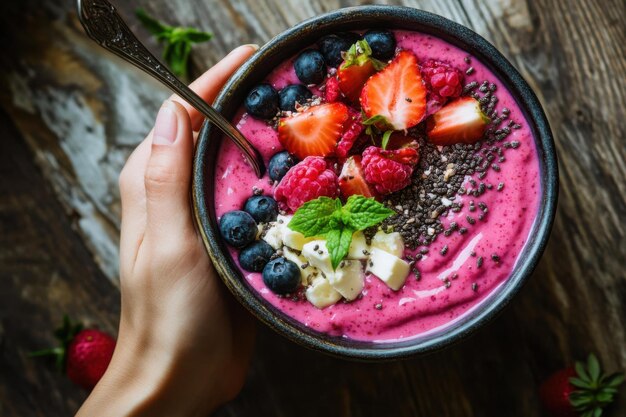
Empetrum nigrum, commonly known as cowberry, is a small, dark berry celebrated for its unique taste and abundant health benefits. Although often overshadowed by more common berries, this nutritious fruit has played an essential role in traditional diets across Europe, North America, and Asia. In this guide, we’ll uncover the numerous benefits, culinary uses, and tips for cultivating these versatile berries.
What is Cowberry?
Known also as lingonberry, this low-growing shrub thrives in acidic soils of cool regions worldwide. Unlike cranberries, they possess a more subtle sweetness that enhances a variety of dishes. Cowberry (Vaccinium vitis-idaea) flourishes best in forests and heathlands, where the soil and climate are ideal.
Nutritional Profile of These Berries
These small, tart fruits are low in calories yet packed with essential nutrients. Regular servings provide:
- Vitamins: High in Vitamin C, Vitamin E, and some B vitamins.
- Minerals: Contains calcium, potassium, and magnesium.
- Antioxidants: Rich in flavonoids and polyphenols that contribute to overall wellness.
Cowberry vs. Cranberry: Key Differences
Though both berries share some similarities, they differ in taste, appearance, and health properties. Cowberries are usually smaller, with a deep red hue and a mildly sweeter taste. Their culinary versatility makes them excellent for unique sauces, jams, and desserts.
Health Benefits of This Berry
Cowberries offer multiple health advantages, making them a great addition to any diet:
- Antioxidant Powerhouse: Helps reduce oxidative stress and inflammation.
- Immune Support: Rich in Vitamin C to bolster immunity.
- Digestive Aid: High fiber content promotes healthy digestion.
- Heart Health: Flavonoids in these berries may lower cholesterol and support cardiovascular health.
- Blood Sugar Management: Some studies indicate potential benefits for blood sugar regulation, making them useful for diabetes support.
Delicious Ways to Enjoy
It is not just a superfood; it’s also incredibly versatile in the kitchen. Here are some delicious recipes to try:
Jam
A simple jam with sugar and lemon juice pairs perfectly with toast or desserts.
Sauce
This sauce makes a fantastic accompaniment to meats, particularly game. Simmer cowberries with sugar and water to create a rich, tangy sauce that enhances the flavors of savory dishes.
Juice
A refreshing drink can be made by blending fresh cowberries with water and sweetening to taste. This juice is not only delicious but also retains the health benefits of the berries.
Yogurt
Mix cowberries into yogurt for a nutrient-packed breakfast or snack. The tartness of the berries pairs well with the creaminess of yogurt.
Kissel
Kissel is a traditional fruit dessert that can be made with cowberries. Combine the berries with sugar and water, thicken with cornstarch, and serve chilled.
Frozen Yogurt
A delightful twist on traditional frozen yogurt, frozen yogurt combines the tartness of cowberries with the creaminess of yogurt for a refreshing dessert. Simply blend yogurt, fresh cowberries, and a sweetener of your choice, then freeze.
Smoothie

Blend cowberries with bananas, spinach, and almond milk for a nutritious and tasty smoothie. This vibrant drink is packed with antioxidants and vitamins.
Growing Cowberries Plants: A Gardener’s Guide
Interested in cultivating your own cowberries? Here’s a step-by-step guide:
Selecting a Location
Choose a spot with acidic, well-drained soil and partial sunlight. Cool temperatures are ideal for their growth.
Planting and Care
Plant in spring or fall, spacing the bushes to allow growth. Water regularly, particularly in dry conditions, and use an acidifying fertilizer for optimal growth.
Care and Maintenance
Watering: Cowberries require regular watering, especially during dry periods. Ensure the soil remains moist but not waterlogged.
Fertilizing: Apply an acidifying fertilizer to promote healthy growth.
Pruning: Prune your plants to remove any dead or diseased branches and to encourage new growth.
Pests and Diseases
These resilient plants resist most pests, though monitoring for leaf spots or root rot is recommended.
Cowberries Plant in Sims 4
These plants are also featured in The Sims 4, where players can harvest berries and create virtual recipes. Discovering and growing these bushes in the game introduces a playful twist to gardening and cooking.
- How to Get Cowberry in Sims 4: Explore the world or visit community lots to find their plants.
- How to Plant a Cowberry in Sims 4: Simply select the Cow Berry bush from your inventory and place it in your garden.
Where to Buy
If you’re not up for growing your own, you can buy cowberries and their products at local farmers’ markets, specialty grocery stores, or online. Here are some options for purchasing cowberries:
Local Grocery Stores
Many grocery stores, especially those focusing on organic or health foods, may carry fresh or frozen cowberries.
Farmers' Markets
Visiting local farmers’ markets can provide access to fresh cowberries, as well as homemade products of these like jams and jellies.
Online Retailers
You can also find cowberries online through retailers like Amazon, where you can purchase fresh, dried, or frozen cowberries. Look for specialty sites that focus on health foods for more options.
Specialty Food Stores
Some specialty food stores and health food shops stock berry products including jams, juices, and dried berries.
General and Medicinal Uses
Beyond its culinary applications, it has a long history of medicinal uses. Traditionally, it has been used to treat various ailments, including urinary tract infections, and digestive issues, and as a natural remedy for colds and fevers.
Extract
Cow berry extract is often used in supplements and natural remedies due to its antioxidant properties. It is believed to support overall health and may provide additional benefits beyond what fresh berries offer.
Tea
Brewing tea is another way to enjoy the health benefits of this fruit. Steep dried leaves in hot water for a soothing tea that is rich in antioxidants and may aid digestion.
Exploring the Flavor Profile
It has a unique flavor that sets it apart from other berries. The taste is often described as tart, slightly sweet, and aromatic, making it a delightful addition to various dishes. Here are some considerations regarding its flavor profile:
Taste and Aroma
Cowberries are known for their bright, tangy taste, which can add a refreshing element to both sweet and savory recipes. The aroma is often floral with earthy undertones, making them appealing in culinary applications.
Pairing with Other Ingredients
Cowberries pair well with many flavors, including:
- Sweeteners: Sugar, honey, or maple syrup can enhance their natural tartness.
- Spices: Cinnamon, cloves, and nutmeg complement the berry’s flavor in desserts and sauces.
- Savory Ingredients: Meats, particularly game, benefit from the tangy sauce made with cowberries.
Different Cultures
They hold cultural significance in various regions, particularly in Scandinavian and Indigenous cultures. Here are a few ways cowberries are celebrated around the world:
Scandinavian Cuisine
In countries like Sweden and Finland, cowberries are a traditional ingredient, often used in jams, sauces, and desserts. They are a staple on the dining table, frequently served alongside game dishes.
Indigenous Uses
Indigenous peoples in North America have used cowberries for generations, both as a food source and for their medicinal properties. They are often incorporated into traditional recipes and remedies.
European Traditions
In various European cultures, cowberries are celebrated during harvest festivals and used in traditional recipes passed down through generations. They symbolize the bounty of nature and are often used in preserves and liqueurs.
Cowberries in the World of Gaming
The presence of cowberry in video games like The Sims 4 has brought attention to this underappreciated fruit. Players can engage in virtual gardening and cooking with cowberries, introducing a younger audience to its benefits and culinary uses. Here are some details:
Gameplay Mechanics
In The Sims 4, players can grow cowberry plants and use them in cooking recipes, fostering an appreciation for gardening and healthy eating.
Virtual Recipes
Recipes like cowberry jam or cowberry smoothies can be created within the game, allowing players to experiment with the berry’s flavor and learn about its uses.
Cowberries in the World of Herbal Remedies
Herbalists have long recognized cowberry for its potential health benefits. Here are some insights into its use in herbal medicine:
Traditional Remedies
Cowberries have been used traditionally to treat various ailments, including:
- Urinary Tract Infections: The antibacterial properties of cowberries make them a popular natural remedy for urinary issues.
- Inflammation: Their anti-inflammatory properties may help alleviate symptoms of arthritis and other inflammatory conditions.
Modern Research
Recent studies are exploring the health benefits of cowberries further, examining their role in preventing chronic diseases and improving overall health. Researchers are investigating the potential of cowberry extracts in supplement form for their antioxidant effects.
Conclusion
It is truly a superfruit that deserves more attention in the world of nutrition and culinary arts. With its impressive health benefits, versatility in the kitchen, and cultural significance, it is a fruit worth exploring. Whether you grow your own or purchase them, integrating cowberries into your diet can enhance your overall well-being while adding a burst of flavor to your meals.
Consider trying out some of the delicious recipes mentioned above or experimenting with your culinary creations. With their unique taste and abundant health benefits, cowberries are a valuable addition to any kitchen.
FAQ'S (Frequently Asked Questions)
Yes, cowberries can be eaten raw, although they are quite tart. Many people enjoy them fresh in salads or as a snack.
Cowberries are safe for children, but due to their tartness, it’s a good idea to mix them with sweeter ingredients or prepare them in recipes.
Fresh cowberries can last up to a week in the refrigerator. Dried or frozen cowberries can last several months when stored properly.
Yes, cowberries can be frozen. Rinse and dry them before placing them in airtight containers or freezer bags.
These leaves can be used to make herbal teas, which may offer health benefits similar to those of the berries.
Circus Peanuts Ingredients
Understanding the circus peanuts ingredients can help demystify what makes these candies so unique. The basic ingredients typically include:
- Sugar: The primary sweetener in Circus Peanuts, providing the candy with its signature sweetness.
- Corn Syrup: This ingredient contributes to the chewy texture and helps prevent crystallization of sugar.
- Gelatin: Derived from animal sources, gelatin is a key ingredient that gives Circus Peanuts their marshmallow-like texture. This can be a concern for vegetarians and vegans, so it’s important to check labels.
- Artificial Flavoring: Circus Peanuts are often flavored with banana or vanilla, which adds to their distinctive taste.
- Artificial Colors: Brightly colored, these candies often contain food coloring to enhance their visual appeal.



